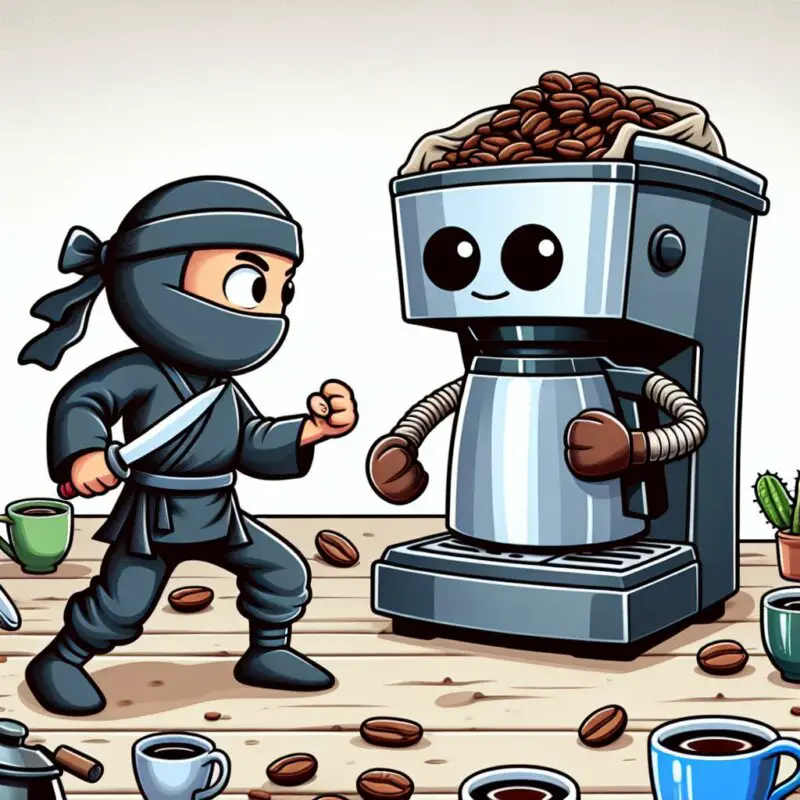This post may contain affiliate links. Please read my disclosure for more info.
Ever found yourself holding up the coffee line, unsure whether to go for a creamy cappuccino or a sweet Frappuccino? And hey, is a Frappuccino just a blended version of a cappuccino?
A cappuccino is a cozy, creamy mix of espresso, steamed milk, and fluffy microfoam, all in equal parts. Meanwhile, a Frappuccino, exclusive to Starbucks, blends iced coffee with espresso, milk, sugar, and sweet flavors for a cool treat.
Dive into the world of cappuccinos and Frappuccinos! We’ll explore their tastes, what goes into them, their health facts, and even how to whip them up in your own kitchen.
What Is Espresso?
Espresso is the magic behind cappuccinos and Frappuccinos. It’s a powerful, concentrated coffee shot made in an espresso machine. This special coffee maker uses 9 bars of pressure to push hot water through tightly-packed coffee, creating a rich and intense flavor.
Some love their espresso pure and strong, while others mix in sweeteners to soften its bold, bitter taste. This blend of flavors has made espresso drinks, like cappuccinos, a hit in cafes all around the globe!
What Is a Cappuccino?
A cappuccino blends espresso, steamed milk, and frothy milk in equal parts, creating a smooth and bold coffee delight. Its creamy taste comes from the sweet, whipped milk, making every sip a rich experience.
Cappuccino vs latte
Even though cappuccinos and lattes are favorites, it’s tricky to spot their differences. They share ingredients, but it’s all in how they’re mixed. Let’s dive into what sets them apart.
- Cappuccinos have layers. Unlike lattes, cappuccinos do not involve stirring espresso and steamed milk together. Hence, cappuccinos have distinct layers after consecutive pouring.
- Cappuccinos have thicker foams. Cappuccinos use milk microfoam that is a third of its overall volume. On the other hand, lattes only use a thin layer so the frothed milk can properly sit on the mixed coffee.
- Cappuccinos have equal ingredient proportions. Cappuccinos follow a 1:1 espresso-to-steamed milk ratio, while lattes have a lower ratio ranging from 1:3 to 1:11.
- Cappuccinos have a higher coffee concentration. Cappuccinos use 1 part steamed milk to 1 part of espresso, while lattes use at least three parts steamed milk to the same shot. With less milk added, cappuccinos contain a higher concentration than lattes.
- Cappuccinos have a stronger coffee flavor. The higher coffee concentration of cappuccinos means fewer milk balances the bitter flavors. Hence, lattes exhibit a sweeter, creamier, and milder coffee flavor than cappuccinos.
What Is a Frappuccino?
A Frappuccino is like a cool coffee milkshake from Starbucks. It mixes espresso, ice, milk, and sugar into a frosty treat. Some new twists skip the coffee and add yummy flavors like strawberry or caramel.
Frappuccinos are known for their sweet taste, which is so intense it might make you question if there’s any coffee in there at all! However, this sweetness comes with a downside. The high sugar content in Frappuccinos might be why they don’t wake you up as effectively as coffees with less sugar.
Even though too much sugar isn’t for everyone, many people love it. That’s why these sweet drinks help Starbucks earn big – over $2 billion a year, making up 20% of their total income!
Frappuccino vs frappe
Check out the difference between Frappuccinos and frappes. Both are icy, blended coffee treats great for cooling down. But don’t be fooled – they’re not the same! Let’s dive into what sets them apart.
- Frappuccinos are Starbucks-owned. In 1995, Starbucks gained exclusive rights for the “Frappuccino” product line, so they are the only ones who can legally sell the drink. Meanwhile, the frappe does not have a trademark, so cafes are free to use and market it in their menus.
- Frappuccinos use an espresso base. Frappuccinos consist of an espresso base which you can modify with extra espresso shots in your venti. On the other hand, frappes have had an instant coffee base since their accidental discovery in the 1950s.
- Frappuccinos may be caffeine-free. If a Frappuccino recipe omits the coffee base, the resulting drink is a flavored milkshake with zero caffeine content. In contrast, frappes always contain caffeine due to their instant coffee component.
- Frappuccinos are more versatile. Frappuccinos don’t follow a strict brewing method for it to be a Frappuccino, so there’s no limit to what it can be. On the other hand, tweaking a frappe changes the resulting drink.
Similarity Between Frappuccino and Cappuccino
Frappuccinos and cappuccinos might sound similar and even share some traits. Click here to discover what makes these coffee drinks both unique and alike!
- Espresso base. Frappuccinos and cappuccinos use espresso as their coffee base. However, Frappuccinos may also use Frapp Roast, a Starbucks-developed instant coffee base for Frappuccino.
- Milk component. Frappuccinos typically use whole milk unless you request non-fat or dairy-free milk from your Starbucks barista. On the other hand, cappuccinos use steamed milk and milk microfoam in their layers.
- Caffeine amount. With an espresso shot as the base, Frappuccinos and cappuccinos should contain close to the same amount of caffeine – about 65 mg. This amount applies to a 12 oz Frappuccino with no extra espresso.
Difference Between Frappuccino and Cappuccino
Many people mix up Frappuccinos and cappuccinos because they sound alike. However, they’re quite different in taste, health benefits, how they’re served, and their origins. Let’s dive into what sets them apart!
- Frappuccinos are Starbucks-trademarked. Frappuccinos have been exclusively owned and sold by Starbucks since 1995. On the other hand, cappuccinos are not exclusive to any person or company.
- Frappuccinos are always cold. Frappuccinos involve blended ice, so they are typically cold-served. In contrast, cappuccinos may be hot due to the steamed milk and hot espresso or cold due to added ice cubes, frozen espresso base, or cold milk.
- Frappuccinos can be caffeine-free. Since Starbucks holds the Frappuccino line of products, they can release non-caffeinated flavors – either with a decaf espresso base or no espresso at all. The same does not apply to cappuccino which requires espresso.
- Frappuccinos are sweeter. Frappuccinos contain milk, sugar, and other sweeteners that overpower the bitter espresso. Meanwhile, cappuccinos use milk that only slightly mellows the bold coffee taste.
- Frappuccinos are less healthy. Frappuccinos generally have higher calorie and sugar counts than a cappuccino. For example, a grande Cinnamon Roll Frappuccino contains 510 calories and 85 g of sugar – way too many calories in one drink and way above the 25 g daily sugar limit.
- Frappuccinos are more versatile. Unlike cappuccino, Frappuccinos do not follow a strict recipe. You can request anything from your Starbucks barista – extra shots, type of milk, and toppings you want in your Frappuccino.
Can I Make Cappuccino and Frappuccino At Home?
Absolutely! To whip up delicious Frappuccinos and cappuccinos at home, all you need is a top-notch espresso machine. Many come with a handy steam wand built right in, so you can froth creamer or milk without extra tools. Check out how to froth creamer easily!
Got your coffee maker? Great! Now, let’s learn how to use it. Check out this simple guide for brewing espresso, whether you have a manual, semi-automatic, or automatic machine.
Alternative ways to make cappuccino and Frappuccino at home
No espresso machine? No problem! You can still whip up a cappuccino or Frappuccino right at home. Just use a budget coffee maker to create an espresso-like base. Simple and delicious!
- Aeropress. Aeropress mimics espresso with a coffee concentrate brewed through a manual push of a plunger. The resulting Aeropress espresso is an alternative for the coffee base of your cappuccino and Frappuccino.
- Nespresso. Nespresso is a pod-based coffee maker that uses pre-measured coffee packets to brew coffee. You can either use Nespresso cappuccino pods or espresso pods for the base of your Frappuccino.
- Keurig. Like Nespresso, Keurig also uses coffee pods to brew coffee without the hassle. The trick is finding the best coffee K-Cups for your cappuccino and Frappuccino. Once you have that, the machine should take care of the rest.
Frequently Asked Questions
Are cappuccinos hot?
Cappuccinos are served hot by default, but you can also get an iced cappuccino if that’s your preference. For a hot cappuccino, layer equal parts espresso, steamed milk, and milk foam into a cup. For a chilled cappuccino, switch to frozen espresso cubes, add ice, or use cold milk.
Are Frappuccinos cold?
Yes, Frappuccinos are always cold since they contain coffee, ice, milk, and other sweeteners. Consuming it while chilled is also best to prevent ice from melting, avoid watery coffee, and maintain its slushy consistency.
Cappuccino vs Frappuccino: A Look into Milky Espresso
We’ve explored the world of creamy espresso beverages, making it easy for you to choose your favorite. If you’re aiming for a sweet coffee without sugar at home, go for a cappuccino. For those lazy moments when you need a sugary fix, a Frappuccino will hit the spot.
Ready to test your coffee skills? Try brewing strong coffee at home or explore the boldest Starbucks blends. You might find a new favorite!



